
Stamford, Connecticut was inhabited by Siwanoy Native Americans, prior to European colonization beginning in the mid-17th century. Stamford grew rapidly due to industrialization in the late-19th and early-20th century, and continued to grow rapidly throughout much of the mid-20th century. During the late-20th century, Stamford underwent a period of urban renewal which saw much redevelopment in its downtown. Stamford's population has continued to grow throughout the 21st century, with redevelopments in its downtown and the South End.

St. Michael's Church is a historic Episcopal church at 225 West 99th Street and Amsterdam Avenue on Manhattan's Upper West Side in New York City. The parish was founded on the present site in January 1807, at that time in the rural Bloomingdale District. The present limestone Romanesque building, the third on the site, was built in 1890–91 to designs by Robert W. Gibson and added to the National Register of Historic Places in 1996.

St. Luke's Episcopal Church, formerly the Episcopal Church of the Resurrection, is a historic Episcopal church in the Sayler Park neighborhood of Cincinnati, Ohio, United States. Designed in the 1870s by master architect Samuel Hannaford, it has been named a historic site.

Walnut Hills United Presbyterian Church is a historic church tower in the Walnut Hills neighborhood of Cincinnati, Ohio, United States. The last remnant of a landmark church building, it was designed by a leading Cincinnati architect and built in the 1880s. Although named a historic site a century after its construction, the building was mostly destroyed after extensive neglect caused restoration to become prohibitively expensive.
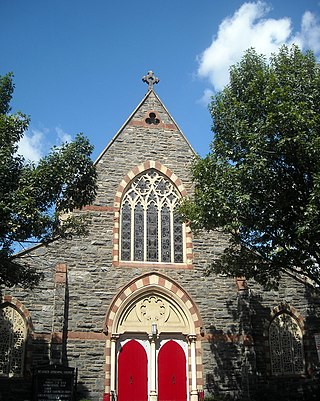
St. Luke's Episcopal Church is a historic Episcopal church located at 1514 15th Street, N.W., in Washington, D.C. Completed in 1879, it is home to the oldest African-American Episcopal congregation in the city. It was designated a U.S. National Historic Landmark in 1976 for its association with Rev. Alexander Crummell (1819–1898), a leading figure advocating black self-sufficiency and civil rights in the mid-19th century.
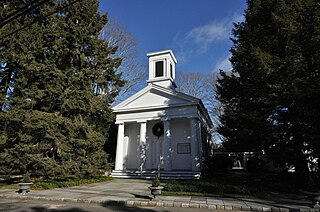
The Long Ridge Village Historic District is a historic district in the city of Stamford, Connecticut. The district, located in rural northern Stamford near the border with New York, was listed on the National Register of Historic Places in 1987. Although the district includes a few early 19th-century properties, the area was most heavily developed between 1850 and 1920, and was a local center of shoe manufacturing until it was bypassed by railroads, sending the business nearer to downtown Stamford. The district extends along Old Long Ridge Road, and includes several property on adjacent Rock Rimmon Road. There are 34 historically significant houses, and two churches.
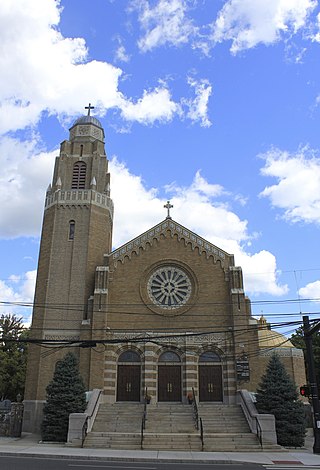
Holy Name of Jesus Parish is a church in Stamford, Connecticut, United States, founded on July 19, 1903. It is one of the Polish-American Roman Catholic parishes in New England in the Diocese of Bridgeport. Holy Name of Jesus Church is the second oldest Catholic Church in Stamford.
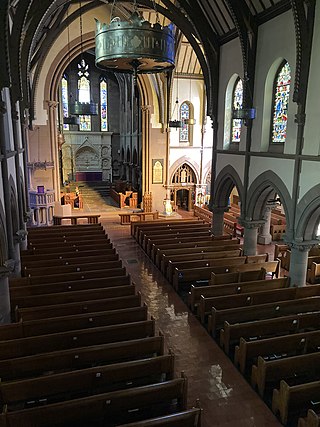
St. John's Protestant Episcopal Church is an historic church located at 628 Main Street in Stamford, Connecticut. The church is an English Gothic Revival structure, built in 1891 to a design by William Potter. It has buttressed stone construction, with a compound-arch entry and a large rose stained-glass window. The associated parish house, also a Gothic Victorian structure, was designed by Richard M. Upjohn and built in 1869–72.

St. Peter's Episcopal Church is a historic Episcopal church located at 19 Smith Street in Port Chester, Westchester County, New York.
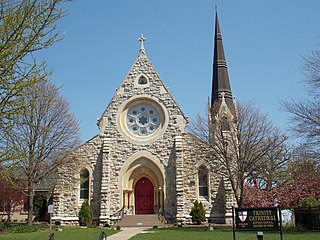
Trinity Episcopal Cathedral, formerly known as Grace Cathedral, is the historic cathedral in the Diocese of Iowa. The cathedral is located on the bluff overlooking Downtown Davenport, Iowa, United States. Completed in 1873, Trinity is one of the oldest cathedrals in the Episcopal Church in the United States. It was individually listed on the National Register of Historic Places in 1974. In 1983 the cathedral was included as a contributing property in the College Square Historic District, which is also listed on the National Register.

Robert W. Gibson, AIA, was an English-born American ecclesiastical architect active in late-nineteenth- and early-twentieth-century New York state. He designed several large Manhattan churches and a number of prominent residences and institutional buildings.
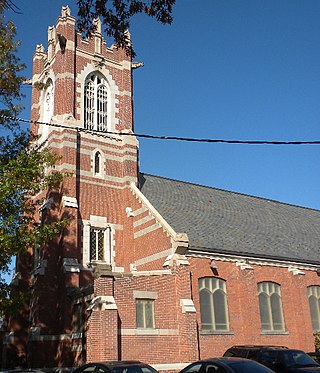
St. Luke's Episcopal Church is a historic church at 111-113 Whalley Avenue in New Haven, Connecticut. Built in 1905 for a congregation founded in 1844, it is a good example of late Gothic Revival architecture, and is further notable as the second church in the city established as an African-American congregation. It was listed on the National Register of Historic Places in 2003.

St. Paul's Episcopal Church in Chattanooga, Tennessee, is a downtown congregation of the Episcopal Church. It is one of the largest congregations in the Episcopal Diocese of East Tennessee.

Trinity Episcopal Church is a parish church in the Episcopal Diocese of Iowa. The church is located in Iowa City, Iowa, United States. It was individually listed on the National Register of Historic Places in 1974. In 2021, the building was included as a contributing property in the Iowa City Downtown Historic District.
This is a list of the properties and historic districts in Stamford, Connecticut that are listed on the National Register of Historic Places. The locations of National Register properties and districts for which the latitude and longitude coordinates are included below, may be seen in an online map.

St. Paul's United Methodist Church is located in downtown Cedar Rapids, Iowa, United States. The Louis Sullivan-designed building has been individually listed on the National Register of Historic Places since 1985. In 2000 it was included as a contributing property in the Second and Third Avenue Historic District.
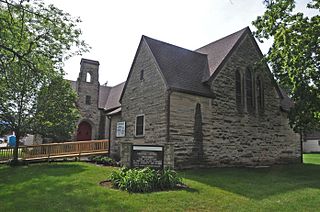
St. Luke's Methodist Church is a Late Gothic Revival church in Monticello, Iowa whose church building was completed in 1950. It is now the Monticello Heritage and Cultural Center. It is the only church in Iowa designed by nationally prominent architects Cram & Ferguson, who specialized in ecclesiastical architecture.
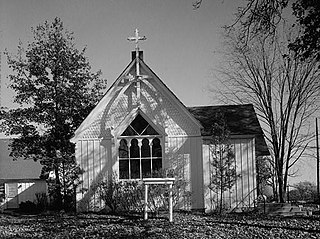
St. Katherine's Chapel, also known as St. Katherine's Episcopal Chapel, is an historic Episcopal church building located at 4650 North Meridian Road in Williamston Township, near Williamston, Michigan, United States.

The Church of the Holy Cross (Episcopal), which housed St. Mark's until 1954, is a historic church at 875 Cotton Street in Shreveport, Louisiana, United States. The first services of the Episcopal church in Shreveport were celebrated by the Rt. Rev. Leonidas Polk, the Bishop of Louisiana in March 1839. That liturgy is considered the founding day of St. Mark's Church. Prior to this church building, the church was located on Fannin Street. St. Mark's moved into a new church building at Fairfield Avenue and Rutherford Street in 1954. That church became the cathedral of the Diocese of Western Louisiana on July 7, 1990.

The Park-to-Park Residential Historic District in Fort Madison, Iowa, United States, was listed on the National Register of Historic Places in 2014. The historic district is located to the north of the Downtown Commercial Historic District, generally between Central Park on the west and Old Settler's Park on the east. Both parks are contributing sites. For the most part the district is made up of single family homes built in the late 19th and early 20th centuries. Some of these homes were built as rental properties, while others became so in later years. The Albright House and the Chief Justice Joseph M. Beck House are contributing properties, and they are also individually listed on the National Register. There are also duplexes and a few small scale apartment buildings in the district.





















